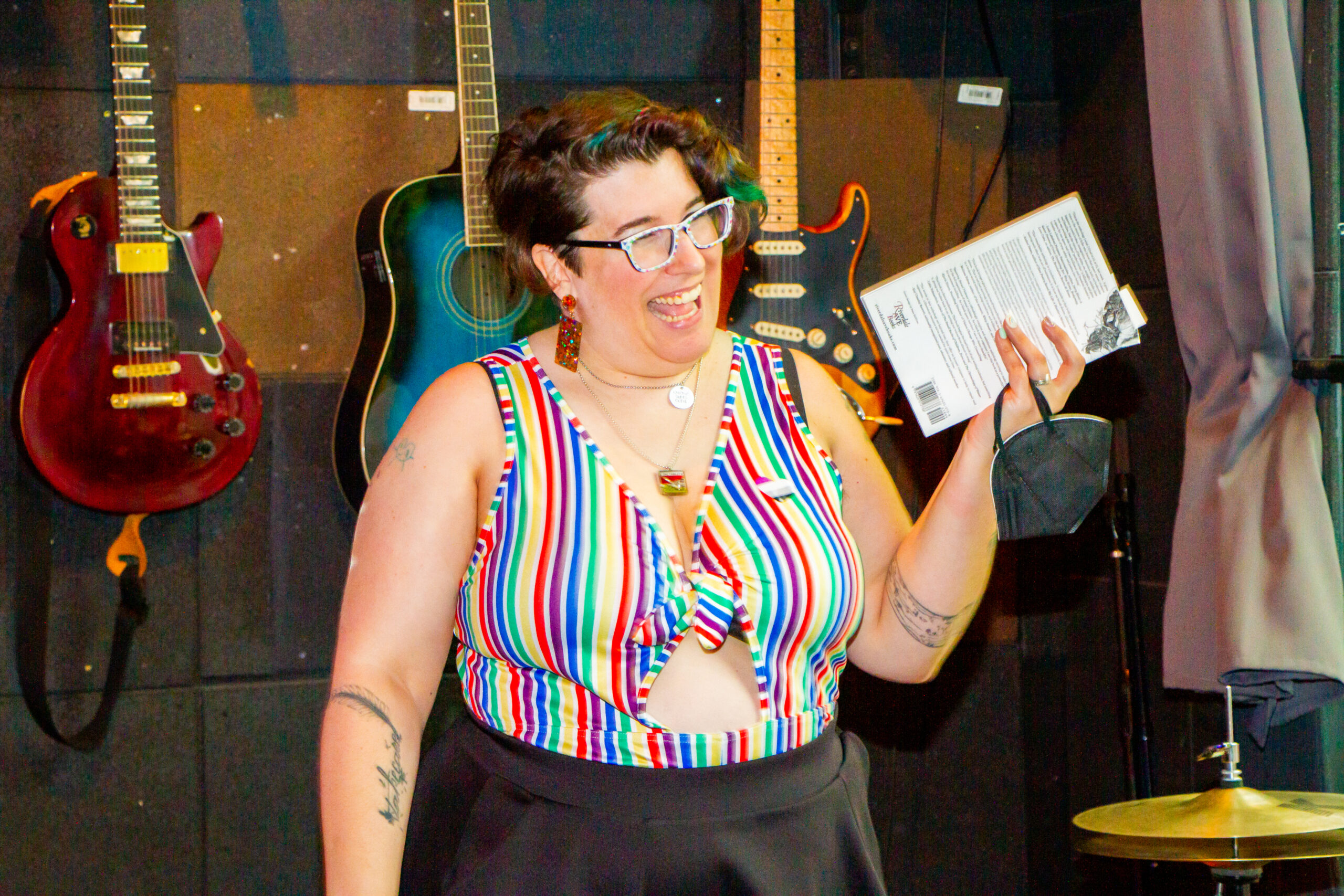

While mindlessly scrolling social media this week I saw a meme that said “I wear pride because you make them hide.” I stopped my scrolling, went back, and read that line over and over again. I realized in that moment that, even more than celebration, pride for me is about visibility. It is about being seen, and also seeing others like me being represented. Pride is the excitement I get when I’d see another visibly Queer mom at the park with her kid, or the giddiness I feel when I’m immersed in a book and suddenly a non-binary character is introduced.
As I was contemplating this, I realized it was the same feeling anytime I’m out in the world and see another young cane user. It is the same feeling I experience when I am onstage performing an act about disability and see someone in the front rows with tears in their eyes. The same way that LGBTQIA+ pride for me is about being visible, so is disability pride.
Seeing and Being Seen
I began realizing I was Queer in my early 30s, just a year or so before I became disabled. However, I only came out because I started seeing more Queer representation, and several people recognized my true identity before I could fully grasp it myself.
I enrolled in a burlesque class, which immediately introduced me to a body-positivity community like none I’d ever encountered before. But more than that, I found myself surrounded by many Queer people — significantly more than my previously sheltered life had allowed.
It was here that I started to understand that my life experiences didn’t make me strange or disgraceful (as my childhood religion had led me to believe); they just made me, well, me…and a part of a community different than the one I’d known before.
Although I hadn’t publicly come out yet, I developed a Queer burlesque persona and began frequenting queer spaces and communities. Gradually, with the encouragement of my friends, I started to acknowledge that this was my identity too. One friend questioned how it felt to live authentically onstage while concealing parts of myself in my daily life. Another friend candidly asked if I’d ever contemplated the possibility that I might be gay.
Honestly, I hadn’t. Growing up in a conservative evangelical home, it hadn’t seemed like a option. But now, it was clear that it wasn’t about whether it was an option or not; the truth was that I had always been Queer, but I hadn’t recognized myself for who I truly was
Visibility on a Larger Scale
The urgent need for increased visibility in the community is highlighted not only by my personal journey but also by the experiences of others like me, who only realized their Queer identities when they saw themselves reflected in society.
We live in a society that, in many ways, actively challenges the rights of the LGBTQIA+ community. Legislation is often pushed through our government with the intent of reducing our rights. At Pride events, we witness pastors with megaphones proclaiming that God despises us. In schools, students casually use derogatory phrases like “That’s so gay” to label something as undesirable.
It is incredibly important to have positive representation. Through representation, we can enhance the self-esteem of our community members, counter stereotypes, and foster more affirmative attitudes among those outside our community. Representation allows us to demonstrate that we belong, both in our personal lives and in society at large.
Parallel Prides
Interestingly, parallels can be drawn to the realm of disability and disability pride. There remains legislation that permits paying disabled individuals less than the minimum wage, and laws that prohibit those on disability from marrying while keeping their benefits.
Moreover, the ideology of eugenics — a belief system aiming to enhance a population’s genetic quality by excluding groups deemed genetically inferior — still finds support in some modern medical practices. Just as children may thoughtlessly use terms like “gay” as a slur in the playground, so too can they misuse ableist words like “lame,” a habit that isn’t exclusive to just children, but can be found in adults as well.
Both LGBTQIA+ and disability communities are marginalized groups and both groups need representation in order to increase visibility, reduce stereotypes and stigma, and create pride in members of the communities.
Wearing My Pride
I’ve been asked about disability pride, “So, are you happy to be sick?” Clearly, nobody is thrilled about experiencing pain or having a condition that could shorten their lifespan. However, for me, pride isn’t about the illness itself. It is about lifting my voice, being seen, and seeing others. It is about celebrating our identities and who we are.
In June, you’ll find me rocking rainbow rompers and glitter. Come July, look for me in my “Disabili-babes” shirt, with my cane covered in twinkly lights. I do these things for a reason.
- I do it for my younger self who didn’t know she was queer because she’d never been around Queer people.
- I do it for myself who was scared nine years ago to get mobility aids because of what people might say.
- I do it for my non-binary teenager who corrects the way others gender them daily.
- I do it for autistic friends who fight to have their needs met in a world that caters to neuro-typical individuals.
- I do it for the someday teen who realizes he likes boys, and I do it for the someday child who is born with a seizure disorder.
I wear my pride. I wear it because I no longer want to hide. I wear it so they don’t have to hide either.





